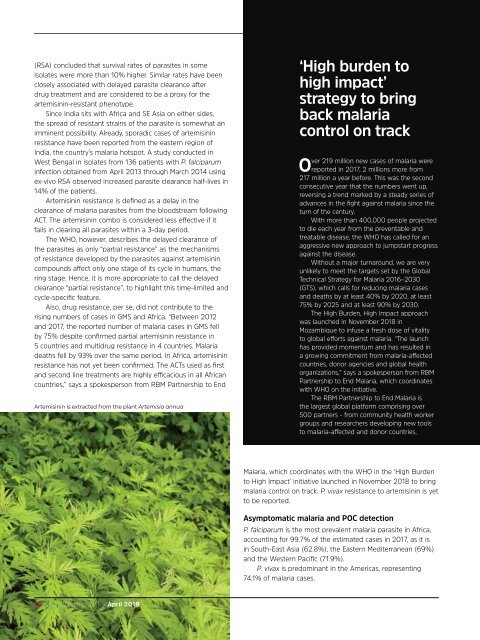Create successful ePaper yourself
Turn your PDF publications into a flip-book with our unique Google optimized e-Paper software.
(RSA) concluded that survival rates of parasites in some<br />
isolates were more than 10% higher. Similar rates have been<br />
closely associated with delayed parasite clearance after<br />
drug treatment and are considered to be a proxy for the<br />
artemisinin-resistant phenotype.<br />
Since India sits with Africa and SE Asia on either sides,<br />
the spread of resistant strains of the parasite is somewhat an<br />
imminent possibility. Already, sporadic cases of artemisinin<br />
resistance have been reported from the eastern region of<br />
India, the country’s malaria hotspot. A study conducted in<br />
West Bengal in isolates from 136 patients with P. falciparum<br />
infection obtained from <strong>April</strong> 2013 through March 2014 using<br />
ex-vivo RSA observed increased parasite clearance half-lives in<br />
14% of the patients.<br />
Artemisinin resistance is defined as a delay in the<br />
clearance of malaria parasites from the bloodstream following<br />
ACT. The artemisinin combo is considered less effective if it<br />
fails in clearing all parasites within a 3-day period.<br />
The WHO, however, describes the delayed clearance of<br />
the parasites as only “partial resistance” as the mechanisms<br />
of resistance developed by the parasites against artemisinin<br />
compounds affect only one stage of its cycle in humans, the<br />
ring stage. Hence, it is more appropriate to call the delayed<br />
clearance “partial resistance”, to highlight this time-limited and<br />
cycle-specific feature.<br />
Also, drug resistance, per se, did not contribute to the<br />
rising numbers of cases in GMS and Africa. “Between 2012<br />
and 2017, the reported number of malaria cases in GMS fell<br />
by 75% despite confirmed partial artemisinin resistance in<br />
5 countries and multidrug resistance in 4 countries. Malaria<br />
deaths fell by 93% over the same period. In Africa, artemisinin<br />
resistance has not yet been confirmed. The ACTs used as first<br />
and second line treatments are highly efficacious in all African<br />
countries,” says a spokesperson from RBM Partnership to End<br />
Artemisinin is extracted from the plant Artemisia annua<br />
‘High burden to<br />
high impact’<br />
strategy to bring<br />
back malaria<br />
control on track<br />
Over 219 million new cases of malaria were<br />
reported in 2017, 2 millions more from<br />
217 million a year before. This was the second<br />
consecutive year that the numbers went up,<br />
reversing a trend marked by a steady series of<br />
advances in the fight against malaria since the<br />
turn of the century.<br />
With more than 400,000 people projected<br />
to die each year from the preventable and<br />
treatable disease, the WHO has called for an<br />
aggressive new approach to jumpstart progress<br />
against the disease.<br />
Without a major turnaround, we are very<br />
unlikely to meet the targets set by the Global<br />
Technical Strategy for Malaria 2016–2030<br />
(GTS), which calls for reducing malaria cases<br />
and deaths by at least 40% by 2020, at least<br />
75% by 2025 and at least 90% by 2030.<br />
The High Burden, High Impact approach<br />
was launched in November 2018 in<br />
Mozambique to infuse a fresh dose of vitality<br />
to global efforts against malaria. “The launch<br />
has provided momentum and has resulted in<br />
a growing commitment from malaria-affected<br />
countries, donor agencies and global health<br />
organizations,” says a spokesperson from RBM<br />
Partnership to End Malaria, which coordinates<br />
with WHO on the initiative.<br />
The RBM Partnership to End Malaria is<br />
the largest global platform comprising over<br />
500 partners - from community health worker<br />
groups and researchers developing new tools<br />
to malaria-affected and donor countries,<br />
Malaria, which coordinates with the WHO in the ‘High Burden<br />
to High Impact’ initiative launched in November 2018 to bring<br />
malaria control on track. P. vivax resistance to artemisinin is yet<br />
to be reported.<br />
Asymptomatic malaria and POC detection<br />
P. falciparum is the most prevalent malaria parasite in Africa,<br />
accounting for 99.7% of the estimated cases in 2017, as it is<br />
in South-East Asia (62.8%), the Eastern Mediterranean (69%)<br />
and the Western Pacific (71.9%).<br />
P. vivax is predominant in the Americas, representing<br />
74.1% of malaria cases.<br />
22 / FUTURE MEDICINE / <strong>April</strong> <strong>2019</strong>


















